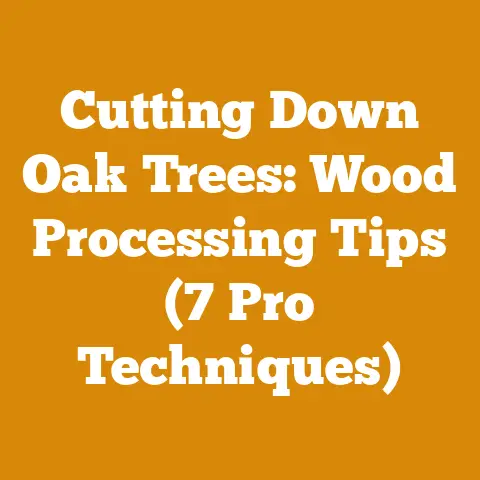How Much Does a Tree Weigh on Average? (5 Arborist Methods)
Alright, let’s dive into the fascinating world of tree weights!
The Myth of the Average Tree Weight
Before we even begin, let’s dispel a common myth: there’s no such thing as a truly “average” tree weight. You can’t just say, “an average tree weighs X tons.” It’s like saying “an average car costs Y dollars” – it’s far too broad. A young sapling and a centuries-old oak are both trees, but their weights are universes apart. Tree species, age, moisture content, and overall health all play massive roles.
I’ve spent years in the wood processing and firewood preparation industry, and I’ve seen trees of the same species vary wildly in weight. A seemingly identical pair of oak trees, grown side-by-side, can have drastically different weights due to subtle variations in soil composition, sunlight exposure, or even past injuries. This is why arborists rely on estimations and calculations rather than simple averages.
How Much Does a Tree Weigh on Average? (5 Arborist Methods)
Determining the weight of a tree is crucial for several reasons. In logging, it dictates the type of equipment needed for felling and transporting timber. In urban forestry, knowing the weight helps plan for tree removal and disposal safely. Even for firewood preparation, understanding the approximate weight assists in estimating yield and planning for storage.
Here are five methods arborists use to estimate tree weight, explained in detail:
1. The Volume-Based Estimation Method
This is perhaps the most common method, and it’s based on calculating the tree’s volume and then multiplying by the wood’s density. It’s a great starting point when you don’t have access to specialized equipment.
Step 1: Measuring the Tree
-
Diameter at Breast Height (DBH): This is the diameter of the tree trunk measured at 4.5 feet (approximately 1.37 meters) above ground level. I typically use a diameter tape for this. A diameter tape has inches on one side and the corresponding diameter in inches on the other, making the measurement direct. If you don’t have a diameter tape, you can measure the circumference with a regular tape measure and divide by pi (π ≈ 3.14159) to get the diameter.
- My Experience: I remember once trying to estimate the weight of a massive sugar maple for a firewood order. The DBH was so large, I had to enlist a colleague to help hold the tape! We measured a circumference of 157 inches, which gave us a DBH of approximately 50 inches.
-
Height: Estimating the tree’s height is a bit trickier. There are several methods:
-
Clinometer: A clinometer is a tool that measures angles. You stand a known distance from the tree, measure the angle to the top and bottom, and use trigonometry to calculate the height.
- Smartphone Apps: There are surprisingly accurate smartphone apps that use your phone’s camera and accelerometer to estimate height.
-
The “Stick Method”: This is a simpler, less precise method. Hold a stick at arm’s length, aligning the top of the stick with the top of the tree and the bottom of the stick with the base of the tree. Then, have someone move along the base of the tree until they are at the same angle as your eye. The distance from the base of the tree to that person is roughly the tree’s height.
-
My Insight: I find that practicing with a clinometer on trees of known heights helps improve your estimation skills. It’s also important to account for sloping ground, which can significantly affect height measurements.
Step 2: Calculating Volume
The formula for calculating the volume of a tree trunk is essentially the same as calculating the volume of a cylinder:
-
Volume = π * (radius)² * height
- Where:
- π (pi) is approximately 3.14159
- radius = DBH / 2
- height = estimated height of the tree trunk
- Where:
However, trees aren’t perfect cylinders. To account for the tapering of the trunk, we often use a form factor. A form factor is a number between 0 and 1 that represents the tree’s shape. A tree that is perfectly cylindrical would have a form factor of 1, while a tree that tapers significantly would have a lower form factor.
-
Adjusted Volume = π * (radius)² * height * Form Factor
-
Form factors typically range from 0.4 to 0.7, depending on the tree species and shape. Consult forestry resources for species-specific form factors. For a rough estimate, I usually use 0.5 for conifers (like pines and firs) and 0.6 for hardwoods (like oaks and maples).
-
Example: Let’s say our sugar maple from earlier had an estimated height of 70 feet and a DBH of 50 inches (radius = 25 inches). Using a form factor of 0.6, the volume would be:
- Volume = 3.14159 * (25 inches)² * 70 feet * 0.6
- We need to convert inches to feet: 25 inches = 2.083 feet
- Volume = 3.14159 * (2.083 feet)² * 70 feet * 0.6
- Volume ≈ 570 cubic feet
-
Step 3: Determining Wood Density
Wood density is the mass per unit volume of wood. It varies significantly depending on the tree species and moisture content.
- Dry Wood Density: This is the density of wood that has been dried to a specific moisture content (typically 12%). You can find dry wood density values for various tree species in forestry handbooks or online databases.
- Green Wood Density: This is the density of freshly cut wood, which contains a significant amount of water. Green wood density is higher than dry wood density.
To estimate the weight of a tree, we need to use the green wood density. Green wood density can be estimated using the following formula:
-
Green Wood Density = Dry Wood Density * (1 + Moisture Content)
-
Moisture Content is expressed as a decimal (e.g., 100% moisture content = 1.0)
-
My Tip: Estimating moisture content can be tricky. As a rule of thumb, freshly cut hardwoods often have a moisture content of 80-120%, while softwoods can range from 30-70%. Local conditions (rainfall, humidity) also affect moisture content. I often use a moisture meter to get a more accurate reading, especially when dealing with valuable timber. A good moisture meter is an invaluable tool, and I’ve found the General Tools MMD4E to be reliable and affordable.
-
Finding Density Values: I consult the USDA Forest Service’s Wood Handbook for reliable density values. You can also find this data online.
-
Example: Sugar maple has a dry wood density of approximately 44 lbs/cubic foot. Let’s assume our sugar maple has a moisture content of 100% (1.0).
- Green Wood Density = 44 lbs/cubic foot * (1 + 1.0)
- Green Wood Density = 88 lbs/cubic foot
-
Step 4: Calculating Weight
Now we can finally calculate the estimated weight of the tree:
-
Weight = Volume * Green Wood Density
-
Example: Using our sugar maple example:
- Weight = 570 cubic feet * 88 lbs/cubic foot
- Weight = 50,160 lbs
- Weight ≈ 25 tons
-
Important Considerations:
- This method provides a rough estimate. It doesn’t account for the weight of branches, leaves, or the stump. These can add significant weight, especially for trees with large crowns.
- Wood density can vary within a single tree. The heartwood (the older, inner wood) is typically denser than the sapwood (the younger, outer wood).
- Accuracy depends on the accuracy of your measurements and the accuracy of the density values you use.
2. The Regression Equation Method
This method involves using statistical models (regression equations) that have been developed to predict tree weight based on DBH and height. These equations are often species-specific and can be more accurate than the volume-based method, especially when dealing with a large number of trees.
Step 1: Finding the Right Equation
- Regression equations are developed by researchers who measure the weight of a large sample of trees and then use statistical analysis to find the relationship between weight and other variables (like DBH and height).
-
These equations are typically published in forestry journals or government reports. Your local forestry extension office is a great resource for finding relevant equations for your region and tree species.
- My Experience: I once worked on a project where we needed to estimate the biomass of a large stand of loblolly pine. We found a regression equation developed by a local university specifically for loblolly pine in our region. This saved us a lot of time and effort compared to trying to measure the weight of each tree individually.
Step 2: Measuring DBH and Height
- As with the volume-based method, you’ll need to accurately measure the DBH and height of the tree.
Step 3: Plugging in the Values
-
The regression equation will typically have the following form:
-
Weight = a + b * DBH + c * Height + d * (DBH)² + e * (Height)² + …
- Where:
- Weight is the estimated weight of the tree
- DBH is the diameter at breast height
- Height is the height of the tree
- a, b, c, d, e are coefficients that are specific to the equation
- Where:
-
-
Simply plug in the values for DBH and height and solve the equation to get the estimated weight.
-
Example: Let’s say we find the following regression equation for a specific species of oak:
-
Weight (lbs) = -50 + 2.5 * DBH (inches) + 0.8 * Height (feet)
-
Using our sugar maple example (DBH = 50 inches, Height = 70 feet):
- Weight = -50 + 2.5 * 50 + 0.8 * 70
- Weight = -50 + 125 + 56
- Weight = 131 lbs (This is just an example equation, and the result is unrealistic for a tree of that size. Real regression equations will be more complex and will yield more realistic results.)
-
-
Important Considerations:
- The accuracy of the regression equation depends on how well the equation fits the specific tree you’re trying to estimate.
- Regression equations are typically developed for specific regions and tree species. Using an equation that is not appropriate for your region or species can lead to inaccurate results.
- Some regression equations may require additional variables, such as tree age or crown diameter.
3. The Water Displacement Method (For Smaller Trees or Sections)
This method is based on Archimedes’ principle: the volume of water displaced by an object is equal to the volume of the object. This method is practical for smaller trees, branches, or sections of logs that can be submerged in a container of water.
Step 1: Preparing the Container
- You’ll need a container that is large enough to completely submerge the tree or section of log. A large tub, tank, or even a swimming pool can be used.
- The container should have a way to accurately measure the volume of water displaced. This could be a graduated scale on the side of the container, or you could use a separate container to collect the displaced water and measure its volume.
Step 2: Measuring the Initial Water Level
- Fill the container with water to a known level.
- Carefully record the initial water level.
Step 3: Submerging the Tree or Section
- Carefully submerge the tree or section of log in the water.
- Make sure the entire tree or section is completely submerged. You may need to weigh it down with rocks or other heavy objects.
Step 4: Measuring the Displaced Water Volume
- Record the new water level.
- The difference between the new water level and the initial water level is the volume of water displaced by the tree or section.
Step 5: Calculating the Weight
-
Once you know the volume of the tree or section, you can calculate its weight using the green wood density (as described in the volume-based method).
-
Weight = Volume * Green Wood Density
-
Example: Let’s say we submerge a section of oak log in a tank of water. The water level rises by 2 cubic feet. We know that the green wood density of oak is approximately 70 lbs/cubic foot.
- Weight = 2 cubic feet * 70 lbs/cubic foot
- Weight = 140 lbs
-
Important Considerations:
- This method is only practical for smaller trees or sections of logs that can be easily submerged.
- Make sure the tree or section is completely submerged to get an accurate volume measurement.
- This method doesn’t account for the weight of branches or leaves.
4. Direct Weighing Method (Using Scales)
This is the most accurate method, but it requires specialized equipment: a large scale capable of weighing entire trees or sections of logs. This method is commonly used in logging operations and research studies.
Step 1: Selecting the Right Scale
- The scale must be large enough and have a high enough weight capacity to accommodate the tree or section of log you’re weighing.
- For weighing entire trees, you’ll need a crane scale or a truck scale.
-
For weighing sections of logs, you can use a platform scale or a hanging scale.
- My Insight: I’ve seen logging operations use heavy-duty truck scales to weigh entire loads of logs. These scales are incredibly accurate and can handle weights of up to 80,000 lbs or more.
Step 2: Preparing the Tree or Section
- If you’re weighing an entire tree, you may need to fell it first.
- If you’re weighing a section of log, you’ll need to cut it to the desired length.
Step 3: Weighing the Tree or Section
- Carefully lift the tree or section onto the scale.
- Make sure the tree or section is evenly distributed on the scale to get an accurate reading.
- Record the weight.
Important Considerations:
- This method requires specialized equipment that can be expensive to purchase or rent.
- Safety is paramount when lifting and moving heavy trees or sections of logs. Use appropriate equipment and follow safety procedures.
- The weight you measure will be the green weight of the tree or section. If you need to know the dry weight, you’ll need to take a sample and dry it to determine the moisture content.
5. Using Load Cells and Strain Gauges
This method is more technical and is typically used in research or industrial settings where precise weight measurements are needed. It involves attaching load cells or strain gauges to the tree or log and measuring the strain or force exerted on them.
Step 1: Understanding Load Cells and Strain Gauges
- Load Cells: These are transducers that convert force into an electrical signal. They are typically used to measure the weight of objects.
- Strain Gauges: These are sensors that measure the strain (deformation) of a material. They can be used to measure the force exerted on an object.
Step 2: Attaching the Sensors
- The load cells or strain gauges are attached to the tree or log in a way that allows them to measure the force exerted on them.
- For example, you could attach load cells to the supports of a platform on which the log is placed.
Step 3: Calibrating the System
- The system must be calibrated to ensure that the electrical signal from the load cells or strain gauges accurately reflects the weight of the tree or log.
- This is typically done by placing known weights on the platform and adjusting the calibration settings.
Step 4: Measuring the Weight
- Once the system is calibrated, you can place the tree or log on the platform and measure its weight.
- The electrical signal from the load cells or strain gauges will be converted into a weight reading.
Important Considerations:
- This method requires specialized knowledge of electronics and instrumentation.
- The accuracy of the measurement depends on the quality of the load cells or strain gauges and the accuracy of the calibration.
- This method is typically more expensive than other methods.
Practical Applications in Wood Processing and Firewood Preparation
Understanding tree weight is incredibly important for various aspects of wood processing and firewood preparation. Here are a few examples:
- Estimating Firewood Yield: I often use the volume-based method to estimate the amount of firewood I can get from a felled tree. Knowing the weight per cubic foot allows me to calculate the total weight of firewood and estimate how many cords I can produce. A cord is a stacked pile of wood measuring 4 feet high, 4 feet wide, and 8 feet long (128 cubic feet).
- Choosing the Right Equipment: The weight of a log dictates the type of equipment needed for moving and splitting it. A small log might be manageable with a manual log splitter, while a large log will require a hydraulic log splitter. I use a 27-ton hydraulic splitter for most of my firewood processing, as it can handle logs up to 24 inches in diameter and 25 inches long. I wouldn’t even attempt to split larger logs manually – it’s simply too dangerous and inefficient.
- Planning for Transportation: Knowing the approximate weight of a load of logs is crucial for ensuring that your truck or trailer is not overloaded. Overloading can damage your vehicle and pose a safety hazard. I always check the weight limits of my trailer and truck before hauling logs.
- Calculating Drying Time: The weight of green wood is a key factor in determining how long it will take to dry. Heavier, denser woods with high moisture content will take longer to season than lighter, less dense woods. I aim for a moisture content of 20% or less for firewood. I’ve found that air-drying hardwoods like oak and maple takes at least 6-12 months, while softwoods like pine can dry in 3-6 months. Stacking the wood properly (allowing for good air circulation) and covering it from rain are essential for efficient drying.
Case Study: Estimating Firewood Yield from a Fallen Oak
Recently, a large oak tree fell in my neighbor’s yard. He offered me the wood, and I jumped at the opportunity. Here’s how I used the volume-based method to estimate the firewood yield:
- Measurements: I measured the DBH of the trunk at 36 inches and estimated the usable length of the trunk to be 40 feet.
- Volume Calculation: Using a form factor of 0.6, I calculated the volume:
- Radius = 36 inches / 2 = 18 inches = 1.5 feet
- Volume = 3.14159 * (1.5 feet)² * 40 feet * 0.6
- Volume ≈ 169.6 cubic feet
- Density: I estimated the green wood density of oak to be 75 lbs/cubic foot.
- Weight Calculation:
- Weight = 169.6 cubic feet * 75 lbs/cubic foot
- Weight ≈ 12,720 lbs
- Firewood Yield: Since a cord of wood is 128 cubic feet, I estimated that I could get approximately 1.3 cords of firewood from the trunk of the tree.
This estimate helped me plan for the cutting, splitting, and stacking of the firewood. I knew I would need to rent a log splitter and dedicate a significant amount of space for stacking the wood.
Safety First!
No discussion about tree weight and wood processing is complete without emphasizing safety. Working with trees and heavy equipment can be dangerous if proper precautions are not taken.
- Personal Protective Equipment (PPE): Always wear appropriate PPE, including a hard hat, safety glasses, hearing protection, gloves, and sturdy boots. I never start a chainsaw without my full PPE.
- Chainsaw Safety: If you’re using a chainsaw, make sure you are properly trained and familiar with its operation. Always use a sharp chain and follow safe cutting techniques.
- Log Splitting Safety: When using a log splitter, keep your hands clear of the splitting wedge and follow the manufacturer’s instructions.
- Lifting Techniques: When lifting heavy logs, use proper lifting techniques to avoid back injuries. Bend your knees, keep your back straight, and lift with your legs.
- Working in Pairs: Whenever possible, work in pairs so that someone can assist you in case of an emergency.
Next Steps
Now that you have a better understanding of how to estimate tree weight, you can start applying these methods to your own wood processing and firewood preparation projects.
- Practice: Start by practicing the volume-based method on trees in your yard or neighborhood. Use a diameter tape and a height estimation tool to measure the trees and calculate their approximate weight.
- Research: Research the typical wood density values for the tree species in your area. Consult forestry handbooks or online databases.
- Experiment: Try the water displacement method on smaller branches or sections of logs. This will give you a better understanding of how the method works.
- Invest: Consider investing in a moisture meter to accurately measure the moisture content of your firewood.
- Safety: Always prioritize safety when working with trees and heavy equipment.
Estimating tree weight is not an exact science, but by using these methods and practicing your skills, you can get a reasonably accurate estimate. This knowledge will help you plan your wood processing and firewood preparation projects more effectively and safely. And remember, always consult with a qualified arborist or forestry professional for any complex or hazardous tree work.






